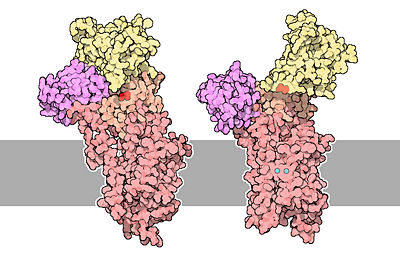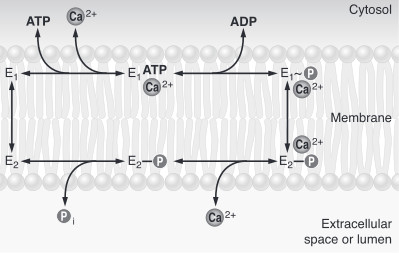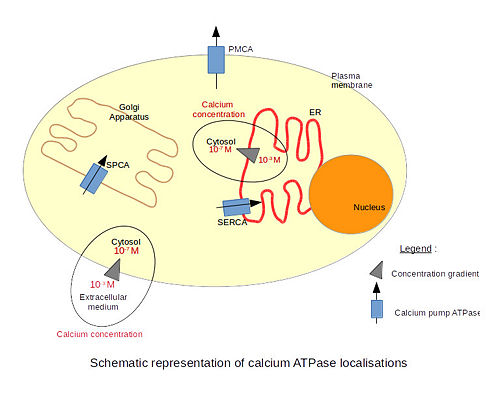Sandbox Reserved 970
From Proteopedia
(Difference between revisions)
| Line 13: | Line 13: | ||
The <scene name='60/604489/Secondary_structure/1'>secondary structure</scene> of the protein is composed of helical regions (47%), beta sheet regions (16%) and loops. There are <scene name='60/604489/10_transmembrane_helices/1'>10 transmembrane alpha helices</scene>, and three of them line a channel that spans the lipid bilayer and that allows calcium to pass through membranes. It also contains too cytoplasmic loops between the transmembrane helices. When the protein is not phosphorylated, two of the transmembrane helices are disrupted and form a cavity that can bind two molecules of calcium. | The <scene name='60/604489/Secondary_structure/1'>secondary structure</scene> of the protein is composed of helical regions (47%), beta sheet regions (16%) and loops. There are <scene name='60/604489/10_transmembrane_helices/1'>10 transmembrane alpha helices</scene>, and three of them line a channel that spans the lipid bilayer and that allows calcium to pass through membranes. It also contains too cytoplasmic loops between the transmembrane helices. When the protein is not phosphorylated, two of the transmembrane helices are disrupted and form a cavity that can bind two molecules of calcium. | ||
| - | The protein is divided in <scene name='60/604489/The_4_domains_of_the_pump/1'>4 regions</scene>. The <scene name='60/604489/Transmembrane_domain/1'>transmembrane region</scene> of the protein contains the channel that | + | The protein is divided in <scene name='60/604489/The_4_domains_of_the_pump/1'>4 regions</scene>. The <scene name='60/604489/Transmembrane_domain/1'>transmembrane region</scene> of the protein contains the channel that spans the lipid bilayer, and the calcium binding cavity. |
The two cytoplasmic loops form three separate domains. The <scene name='60/604489/Nucleotide_binding_domain/1'>nucleotide binding domain (N)</scene> contains the site where ATP binds to the protein. The <scene name='60/604489/P_domain/1'>phosphorylation domain (P)</scene> contains an Aspartate residue (<scene name='60/604489/Asp_351/1'>Asp 351</scene>) that can be phosphorylated. Finally, the <scene name='60/604489/Actuator_domain/1'>actuator domain (A)</scene> is involved in the transmission of major conformational changes. The phosphorylation and the nucleotide binding domains form the <scene name='60/604489/Catalytic_site/1'>catalytic site</scene> of the protein<ref name="first">Benjamin Lewin, 2007 - Cells - Jones & Bartlett Learning</ref>. | The two cytoplasmic loops form three separate domains. The <scene name='60/604489/Nucleotide_binding_domain/1'>nucleotide binding domain (N)</scene> contains the site where ATP binds to the protein. The <scene name='60/604489/P_domain/1'>phosphorylation domain (P)</scene> contains an Aspartate residue (<scene name='60/604489/Asp_351/1'>Asp 351</scene>) that can be phosphorylated. Finally, the <scene name='60/604489/Actuator_domain/1'>actuator domain (A)</scene> is involved in the transmission of major conformational changes. The phosphorylation and the nucleotide binding domains form the <scene name='60/604489/Catalytic_site/1'>catalytic site</scene> of the protein<ref name="first">Benjamin Lewin, 2007 - Cells - Jones & Bartlett Learning</ref>. | ||
Revision as of 19:56, 9 January 2015
Calcium ATPase
| |||||||||||
References
- ↑ 1.0 1.1 Benjamin Lewin, 2007 - Cells - Jones & Bartlett Learning
- ↑ 2.0 2.1 2.2 Marisa Brini , Ernesto Carafoli, 2009 - Calcium pumps in health and disease - Physiological Reviews
- ↑ David Goodsell, 2004 - Calcium pump molecul of the month - PDB, doi: 10.2210/rcsb_pdb/mom_2004_3
- ↑ Thomas D.Pollard and William C. Earnshaw, - Membrane, structure and function - Cell Biology (second edition), p.133-136
- ↑ David H.MacLennan, William J.Rice and N. Michael Green, 1997 - The Mechanism of Ca2+ Transport by Sarco(Endo)plasmic Reticulum Ca2+-ATPases - The Journal of Biological Chemistry, p.272, 28815-28818, http://www.jbc.org/content/272/46/28815.full.html
- ↑ Marianela G.Dalghi, Marisa M.Fernández, Mariela Ferreira-Gomes, Irene C.Mangialavori, Emilio L.Malchiodi, Emanuel E.Strehler and Juan Pablo F.C.Rossi, 2013 - Plasma Membrane Calcium ATPase Activity Is Regulated by Actin Oligomers through Direct Interaction - The Journal of Biological Chemistry, p.288, 23380-23393, http://www.jbc.org/content/288/32/23380.full.
- ↑ Marisa Brini and Ernesto Carafoli, 2010 - The plasma membrane Ca2+ ATPase and the Plasma Membrane Sodium Calcium Exchanger Cooperate in the Regulation of Cell Calcium - Cold Spring Harbor Perspectives in Biology, http://cshperspectives.cshlp.org/content/3/2/a004168.full
- ↑ Nyamkhishig Sambuughin, Elena Zvaritch, Natasha Kraeva, Olga Sizova, Erica Sivak, Kelley Dickson, Margaret Weglinski, John Capacchione, Sheila Muldoon, Sheila Riazi, Susan Hamilton, Barbara Brandom and David H. MacLennan, 2014 - Exome analysis identifies Brody myopathy in a family diagnosed with malignant hyperthermia susceptibility - Molecular Genetics & Genomic Medicine



